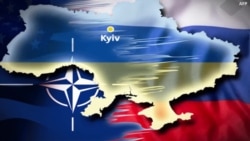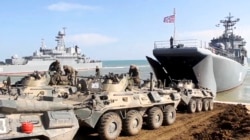On July 5, Russian Deputy Foreign Minister Alexander Grushko claimed that NATO is fully responsible for starting a second Cold War between the West and Russia.
"We do not want a return to the Cold War. It is NATO that is imposing it on us. We are not expanding; we are not setting up our bases somewhere ... " Grushko said in an interview with the Moscow city government-owned daily Argumenty I Fakty.
That statement is false and contradicts the history of the Russian military’s expanding presence abroad over the past 14 years.
Georgia, Armenia, Central Asia
Before the August 2008 Russo-Georgian War, Russia had two military bases in that Caucasus country. The Gudauta base was a training center for the Russian peacekeeping forces of the Commonwealth of the Independent States stationed in Abkhazia. The second base was in South Ossetia, where peacekeepers composed of Ossetians, Russians and Georgians were stationed under an OSCE monitoring mission.
After 2008, Russia expanded and transformed the CIS peacekeepers’ training center in Gudauta into a full-fledged military base for the Russian armed forces. This military base includes four mechanized infantry battalions, a tank battalion, two artillery battalions, a rocket artillery battalion, a sniper company, a drone company and a reconnaissance battalion.
In February 2009, the Russian Armed Forces established the 4th Guards Military Base for troops stationed in the occupied Georgian region of South Ossetia. That base and its 5,000 military personnel are mainly located in the city of Tskhinvali, but separate units are spread across South Ossetia.
In March 2022, units from both Russian military bases in Georgia were deployed to Ukraine to join the invasion forces. “In order to staff the armed forces of the Russian Federation, the units of the 4th (Tskhinvali district, South Ossetia) and 7th (Abkhazia) military bases, which are part of the Southern Military District, were redeployed from the occupied territories of Georgia to Ukraine,” the General Staff of the Armed Forces of Ukraine posted on Facebook.
In Armenia, Russia expanded its 102nd Order of Alexander Nevsky military base, which has existed there since September 1994, by including the 73rd Separate Motorized Rifle Brigade in April 2010.
In Central Asia, Russia has been systematically increasing its military presence, modernizing and expanding its existing bases, and creating new military bases.
Ukraine, Moldova, Belarus
In February 2014, Russia illegally annexed Crimea from Ukraine. Later, new Russian military bases were built on the peninsula. Russia’s Defense Ministry also reopened old Soviet-era bases in occupied Crimea. Former Ukrainian military bases in Crimea have now also become Russian military bases. In September 2016, then British Defense Minister Michael Fallon expressed concern about Russia’s military buildup in Crimea and “the militarization of the Black Sea region generally,” adding that both Bulgaria and Romania felt “very threatened.”
Among the restored Soviet military bases in Crimea is Object-100 Utes, a complex of coastal missile positions located in the mountains near Sevastopol, a Black Sea Ukrainian city also under Russian occupation since 2014. In the fall of 2016, Russian media reported that this base had been restored and would be put into service with the Russian Black Sea Fleet. In 2017, cruise missiles were launched from this base during exercises, and the base was modernized in 2019. “It is a functioning military base with an anti-ship missile system,” a villager told Reuters in July 2016.
Russia also put back into service a chain of Soviet radar stations on the mountain slopes of Crimea. Those stations allow the Russian armed forces to monitor the Black Sea and the movement of ships from NATO members Romania, Bulgaria and Turkey.
One of those radar stations in Crimea, located near the city of Feodosia, was built during the Soviet era but was not subsequently used by the Ukrainian army. It was put back into operation along with an air defense system and missiles, all of which are manned by Russian military personnel.
In February 2015, NATO’s then supreme commander, Gen. Philip Breedlove, said that weapons systems ranging from “air defense systems that reach nearly half of the Black Sea to surface attack systems that reach almost all of the Black Sea area” had made “the platform of Crimea a great platform for power projection into this area.”
Russia has also expanded its air force capabilities on the peninsula. An erstwhile civilian airport in Belbek, Crimea, was converted into a military airfield.
Satellite imagery taken in March 2022 showed that Russia was actively using air bases in occupied Crimea to bomb Ukrainian cities.
Radio Free Europe/Radio Liberty reported that as of November 2021, Russia had built 10 military bases in the occupied territories of eastern Ukraine. Russia’s military used these bases to preposition tanks, armored combat vehicles, artillery, self-propelled anti-aircraft weapons, etc., that were then used in the February 2022 invasion of Ukraine.
As of the beginning of July 2022, Russia wholly or partially occupied six Ukrainian regions, and had established temporary and permanent military bases in them.
The number of Russian military bases in Ukraine is constantly changing because the Ukrainian armed forces regularly hit and destroy them. For example, on July 3, the mayor-in-exile of the Russian-occupied city of Melitopol said that Ukrainian missiles had destroyed one of the four Russian military bases located in the city.
In Moldova, Russia has built a military base on the territory of the so-called Transnistrian Moldavian Republic with about 1,500 military personnel of the former 14th Army of the Soviet Union, now called the Operational Group of Russian Forces in Transnistria (OGRF). In 2013, Russia tried to strengthen this military base by increasing the number of military helicopters, but the Ukrainian authorities prevented that by banning Russian helicopters from flying over Ukraine.
By February 2022, there were two Russian military bases located in Belarus - the 43rd zonal communications center of the Russian Navy in the Minsk region and the 474th separate radio engineering center (ORTU) in the Brest region.
The fact that Russia formally had only two military bases in Belarus did not prevent the Russian army from using the Belarusian military’s nine air bases to launch missile and air strikes on Ukraine in February 2022.
On July 7, the General Staff of the Armed Forces of Ukraine announced that Belarus had transferred the Zyabrkovka airfield to the Russian army. The airfield is now being converted into a new Russian military base.
Middle East, Latin America, Africa, and more
The expansion of Russia's military presence abroad is not limited to the countries of the former Soviet Union.
Since August 2015, Russia has been using Syria’s Khmeimim air base in the northeastern city of Latakia. At the end of 2017, Moscow announced the Khmeimim base would become a component of Russia’s permanent military contingent stationed in Syria. Khmeimim is now the main military base used for Russia’s military intervention in Syria’s civil war.
In May 2021, Russia expanded its permanent military base in the Syrian sea port of Tartus, strengthening its military foothold in the eastern Mediterranean.
In February 2014, Defense Minister Sergei Shoigu said Russia was looking to build military bases in Vietnam, Cuba, Venezuela, Nicaragua, Seychelles, Singapore and several other countries. “The talks are underway, and we are close to signing the relevant documents,” said Shoigu at that time.
In 2017, Russia reached an agreement with Sudan to host a Russian naval base. Russia then announced that it had signed a deal with Sudan on the construction of a “logistics point” for the Russian fleet in Sudan. In March 2022, Mohamed Hamdan Dagalo, deputy head of Sudan's sovereign council, confirmed that Sudan is open to a naval base agreement with Russia.
In his interview with Argumenty I Fakty, Russian Deputy Foreign Minister Alexander Grushko complained that NATO is expanding and threatening Russia. In reality, NATO expansion is a response to Russia’s military activities. Most of the new members that joined NATO in the last 20 years cited Russia’s aggressive behavior as the main reason for their desire to join the alliance.
The fear of Russian military aggression is what prompted Ukraine to seek NATO membership starting in the 1990s. Russia’s 2022 military invasion of Ukraine prompted Sweden and Finland to join NATO. Asked what he would say to Russian President Vladimir Putin about his country’s bid to join NATO, Finnish President Sauli Niinisto responded: “You caused this. Look in the mirror.”







